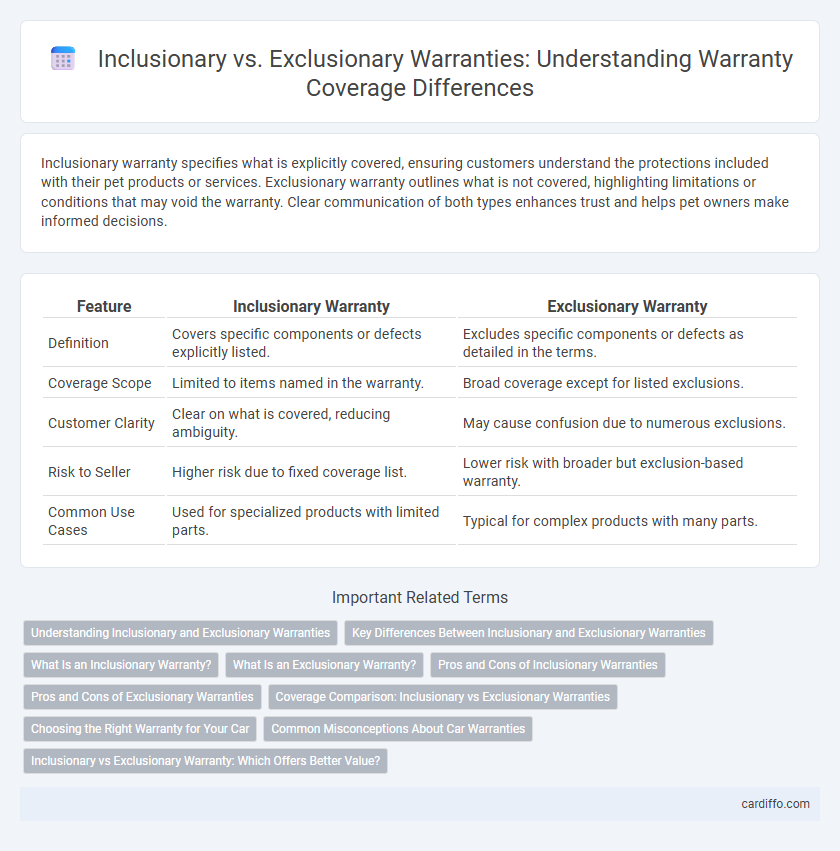Inclusionary warranty specifies what is explicitly covered, ensuring customers understand the protections included with their pet products or services. Exclusionary warranty outlines what is not covered, highlighting limitations or conditions that may void the warranty. Clear communication of both types enhances trust and helps pet owners make informed decisions.
Table of Comparison
| Feature | Inclusionary Warranty | Exclusionary Warranty |
|---|---|---|
| Definition | Covers specific components or defects explicitly listed. | Excludes specific components or defects as detailed in the terms. |
| Coverage Scope | Limited to items named in the warranty. | Broad coverage except for listed exclusions. |
| Customer Clarity | Clear on what is covered, reducing ambiguity. | May cause confusion due to numerous exclusions. |
| Risk to Seller | Higher risk due to fixed coverage list. | Lower risk with broader but exclusion-based warranty. |
| Common Use Cases | Used for specialized products with limited parts. | Typical for complex products with many parts. |
Understanding Inclusionary and Exclusionary Warranties
Inclusionary warranties explicitly define the specific assurances and coverage provided within a contract, ensuring clear protection scope for buyers. Exclusionary warranties, by contrast, specify the limitations and conditions that are not covered, often limiting the seller's liability. Understanding the distinctions between inclusionary and exclusionary warranties helps parties manage risk and clarify responsibilities in legal agreements.
Key Differences Between Inclusionary and Exclusionary Warranties
Inclusionary warranties explicitly define the specific defects or issues covered, providing clear assurances for identified product failures. Exclusionary warranties, on the other hand, list the defects or problems that are not covered, often leaving all other issues implicitly covered or subject to interpretation. The key difference lies in the scope of coverage: inclusionary warranties specify protection scope, while exclusionary warranties clarify limitations and exclusions.
What Is an Inclusionary Warranty?
An inclusionary warranty specifies the exact conditions and defects covered by the warranty, clearly defining what is guaranteed within the product's scope. This type of warranty protects consumers by outlining the specific parts, repairs, or services included, ensuring transparency in coverage. Inclusionary warranties help minimize disputes by detailing allowable claims and maintaining consistent standards of product reliability.
What Is an Exclusionary Warranty?
An exclusionary warranty specifically outlines what is not covered under the warranty agreement, clearly defining the limitations and exclusions that protect the manufacturer or seller from certain liabilities. This type of warranty helps manage customer expectations by listing defects, damages, or conditions that are exempt from repair or replacement obligations. By contrast, an inclusionary warranty focuses on the benefits and repairs guaranteed to the consumer, making exclusionary warranties critical for clarifying the scope of coverage.
Pros and Cons of Inclusionary Warranties
Inclusionary warranties explicitly define the specific protections and obligations covered under a product or service agreement, ensuring clear scope and reducing ambiguity for consumers. They provide the advantage of greater transparency, which helps build trust and facilitates easier claim validation, but may limit coverage flexibility by narrowly detailing what is included. Such warranties can prevent unexpected denials by clearly stating covered scenarios, though they might exclude potential damages or issues not expressly listed, potentially reducing overall protection.
Pros and Cons of Exclusionary Warranties
Exclusionary warranties limit coverage by explicitly stating what is not included, reducing ambiguity and potential disputes over claims, which helps manufacturers control costs and risks. However, these warranties can lead to customer dissatisfaction due to perceived unfairness and unexpected expenses, potentially harming brand reputation and customer loyalty. Legal challenges may arise if exclusions are too broad or unclear, making exclusionary warranties a riskier choice for consumer trust.
Coverage Comparison: Inclusionary vs Exclusionary Warranties
Inclusionary warranties explicitly list components and defects covered, ensuring clear and comprehensive protection for consumers. Exclusionary warranties specify only the parts or conditions not covered, which can lead to greater ambiguity and potential gaps in protection. Coverage comparison reveals that inclusionary warranties offer more predictable and extensive coverage, while exclusionary warranties may limit liability but increase the risk of unexpected costs.
Choosing the Right Warranty for Your Car
Choosing the right warranty for your car involves understanding the differences between inclusionary and exclusionary warranties. Inclusionary warranties specify covered components, offering clear protection on essential parts, while exclusionary warranties list only parts not covered, providing broader overall coverage with exceptions. Evaluating your vehicle's make, model, and typical repair costs helps determine which warranty type offers the best balance of coverage and cost-efficiency.
Common Misconceptions About Car Warranties
Many consumers mistakenly believe that inclusionary warranties cover all parts and defects, while exclusionary warranties list only the components they protect, leaving other areas unguaranteed. Misunderstanding the scope of coverage often leads to unexpected repair costs and dissatisfaction with warranty service. Clarifying the difference between inclusionary and exclusionary warranties empowers car buyers to make informed decisions and avoid costly surprises.
Inclusionary vs Exclusionary Warranty: Which Offers Better Value?
Inclusionary warranties provide explicit coverage for specific repairs and services, ensuring consumers understand exactly what is protected, which often results in greater peace of mind and fewer unexpected costs. Exclusionary warranties list what is not covered, potentially limiting consumer protection and increasing out-of-pocket expenses for unmentioned repairs. Evaluating inclusionary versus exclusionary warranties, inclusionary options generally offer better value by delivering clearer, more comprehensive protection and reducing financial risk to the customer.
Inclusionary Warranty vs Exclusionary Warranty Infographic

 cardiffo.com
cardiffo.com